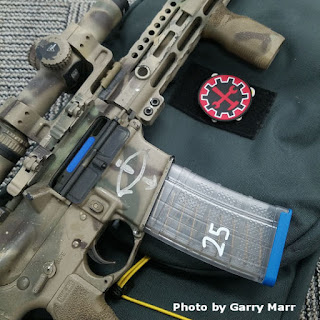 When I was a kid, I used to poorly do tricks on my BMX bike. My friends and I would hang out like typical kids but we’d roam around on our bikes and try to impress each other with the newest tricks we’d been practicing. Like most young men, approval of our peers was important, even if we didn't realize it then. Many years later, after getting out of the Navy and now a newly minted father, I’m watching some kids do some amazing stuff in the X-games. Damn, these dudes were not just on a different level, like the kids in the magazines when I was young, they were from a whole different realm. In one of those cool featurettes, ESPN went behind the scenes with these guys and showed their practice regimens. While they were showing PA’s own Woodward BMX camp (or whatever they call it nowadays) there was a giant foam pit. These dudes were doing insane tricks and landing in the pit. They could push their boundaries with the repercussions for failure almost eradicated. They could perfect their craft in relative safety. At first, I was jaded and called them cheaters, but after setting my ego aside, I realized it was genius and these guys used their brains to be able to push their abilities to the next level.
When I was a kid, I used to poorly do tricks on my BMX bike. My friends and I would hang out like typical kids but we’d roam around on our bikes and try to impress each other with the newest tricks we’d been practicing. Like most young men, approval of our peers was important, even if we didn't realize it then. Many years later, after getting out of the Navy and now a newly minted father, I’m watching some kids do some amazing stuff in the X-games. Damn, these dudes were not just on a different level, like the kids in the magazines when I was young, they were from a whole different realm. In one of those cool featurettes, ESPN went behind the scenes with these guys and showed their practice regimens. While they were showing PA’s own Woodward BMX camp (or whatever they call it nowadays) there was a giant foam pit. These dudes were doing insane tricks and landing in the pit. They could push their boundaries with the repercussions for failure almost eradicated. They could perfect their craft in relative safety. At first, I was jaded and called them cheaters, but after setting my ego aside, I realized it was genius and these guys used their brains to be able to push their abilities to the next level.
The first time I heard about Simunitions was in high school, in one of Dick Marcinko's books. I never gave it more thought than it “seemed like fun.” But years later when I had the opportunity to put my hands on a similar product (federal FX) it was like that foam pit had been dropped into my training world. Here was my way to work on tactics, with the repercussions of failure being just a few welts and a hit to my ego. Sure, I spend lots of time on the square range working on skills, probably like most of the people reading this, but there is very little room for practicing tactics. We can utilize cover, concealment, and barricades, but if we use them poorly or incorrectly? There is nothing to penalize us for doing so. The possibility of ingraining poor tactical habits is high on the flat range. Shooting competitions like IDPA and USPSA actually reward poor use of cover, so those arenas actually cause regression in most competitors in that area. But here, with a non-lethal round fired from proper gear, there was a golden opportunity to work out tactics against live opponents who are also practicing proper tactics. Like anything that we learn, proper repetitions are the key to growth, and here in front of me was nearly endless repetitions with the penalty for failure not being dead, which was how a lot of warriors throughout history learned. But how many were robbed from us by an action that could have been practiced safely prior to facing an opponent intent on killing you?
I embraced this concept. And it has paid dividends. I have learned much more about my abilities and decision making from facing a live opponent than I ever did facing cardboard and steel. I’m not different than anybody reading this article. You and I both can line up sights and press a trigger without disturbing them pretty well, likely better than the vast majority of humans walking the earth. But if we don't get an opportunity to do those two things, it doesn't matter how well we can do them. That is why I tell my students, or anybody that will listen, “If you had to choose between live-fire and Force-On-Force (FoF), ALWAYS pick FoF!” It is that important.
There are a couple key components to having a quality Force-On-Force Experience. First, like any training, a competent Instructor is a must. You might already have found one that you prefer already that offers Force-On-Force classes, and that’s great. If not talk to your live fire Instructors about who they prefer. If they don't have one to recommend, they should get out more. If they recommend against FoF, you should find a new instructor to learn live fire from.
The next thing is quality, trained opponents. Often called “Role Players”, these folks need to be well versed in the lessons being taught. Their goal, like that of the instructor, is to have the student gain the most possible every time they gear up. It’s not a paintball game where both sides are trying to “win.” Winning is when the students learn the intended lesson. Don't get me wrong, the role players are also learning during these as well, they are just at a different point in their training and learning different lessons.
Finally, but still immensely important is equipment. The gear has to be solid and robust. It needs to handle being treated like a real gun. If it can't be dropped, or thrown away from a downed bad guy, its garbage. This is where airsoft fails miserably. Tokyo Marui plastic is not the same as Glock plastic. The pot metal coming from Asia is vastly inferior to steel and aluminum. I’ve broken Airsoft guns just by racking the slide as a pistol is intended. If it needs to be manipulated gingerly to prevent breakage, chuck it. That is something too easily transferred into your live-fire manipulations.
There needs to have some negative reinforcement for fucking up. If getting shot doesn't hurt, it’s not a good training tool. Paintball guns excel here, they have more kinetic energy than any of the simulated rounds on the market. However, not a single manipulation is remotely the same. None of the controls get close to mimicking the controls on the tools you will save your life with. They are not training tools.
There are two general types of quality Force-On-Force options. Simunitions and Federal FX rounds are grouped into the first category. These work out of Glock's factory G17T. The technology for these has been around for decades. They do everything that one needs for FoF training. I have used both, and they were acceptable. The design leaves something to be desired. The soft end of the projectile is easily disfigured during the chambering process, causing a jam that can only sometimes be cleared by the standard immediate action procedure for a pistol (Tap, rack/Unload, reload). The superior option is the new guy on the block, UTM (Ultimate Training Munitions). The modern design of these projectiles has a flexible plastic cage with the marking paint housed inside it. This makes feeding ten-fold more reliable. Another upside is that UTM slides are available for a number of different pistols, allowing students to use their own carry gear (holsters and mag pouches) without going and buying a duplicate set just to fit a schools sim guns. From a schools perspective, it is much easier to purchase UTM slides for civilian training than G17T’s from Glock. As in, Glock does not care if civilians ever receive FoF training and outright refuses to sell guns to schools that train civilians. I’m not alone in my preference for UTM over Sims/FX. The US Army has also transitioned to UTM and left Sims/FX. If the Federal Government can figure out that there is an improvement, it should be pretty obvious to the rest of us.
Just like the foam pit, this is your chance to fail in a safe environment. An opportunity to pressure test your Mindset, your skill, your gear and most importantly, your tactics. As often as your training schedule and budget allows, you should be looking for Force-On-Force training opportunities. Find a school with quality instructors, that use vetted, trained role players and have a stable of UTM gear (Sim/FX if need be) and sign up. I promise you, you will learn more about your abilities in one class than all of the live-fire training you’ve ever done.



